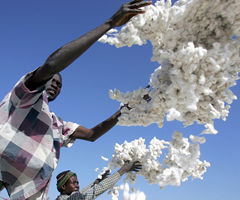Debt and painful reforms (1982–89)

Cotton harvest in Burkina Faso: Prices for commodities from developing countries slumped in the early 1980s because of recessions in industrial countries (photo: Issouf Sanogo/AAFP)
The oil shocks of the 1970s, which forced many oil-importing countries to borrow from commercial banks, and the interest rate increases in industrial countries trying to control inflation led to an international debt crisis.
During the 1970s, Western commercial banks lent billions of "recycled" petrodollars, getting deposits from oil exporters and lending those resources to oil-importing and developing countries, usually at variable, or floating, interest rates. So when interest rates began to soar in 1979, the floating rates on developing countries' loans also shot up. Higher interest payments are estimated to have cost the non-oil-producing developing countries at least $22 billion during 1978–81. At the same time, the price of commodities from developing countries slumped because of the recession brought about by monetary policies. Many times, the response by developing countries to those shocks included expansionary fiscal policies and overvalued exchange rates, sustained by further massive borrowings.
When a crisis broke out in Mexico in 1982, the IMF coordinated the global response, even engaging the commercial banks. It realized that nobody would benefit if country after country failed to repay its debts.
The IMF's initiatives calmed the initial panic and defused its explosive potential. But a long road of painful reform in the debtor countries, and additional cooperative global measures, would be necessary to eliminate the problem.
- Who we are
- Statutes and Decisions
- Evaluation and Audit
- Corporate Citizenship
- More Resources
